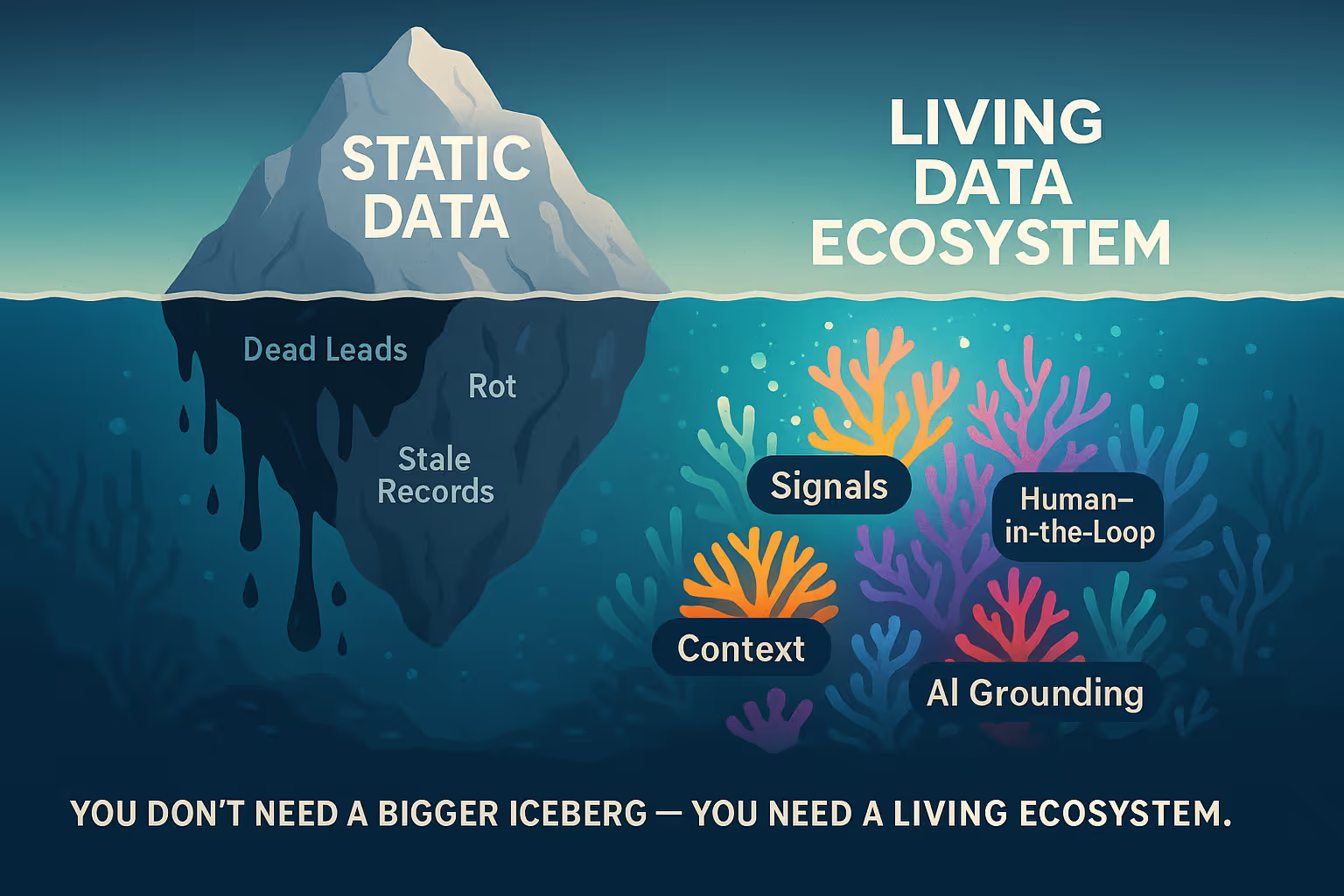For decades, B2B data providers have competed on size — the number of records in their database, the volume of contacts they can export, the illusion of scale as a proxy for intelligence. But in the age of AI, size has stopped being a strength. It’s become a liability.
Because data isn’t oil anymore. It’s oxygen. And oxygen must be clean, circulating, and alive.
This is the quiet revolution happening inside the world’s most sophisticated go-to-market systems. The future of GTM isn’t about who has the most data; it’s about who has the most living data. Context-rich, signal-driven, refreshed in real time. Let’s unpack why static data is dead—and what replaces it.
Part 1: The Decay Problem — Why 30% of Databases Rot Quarterly
Every database dies in silence.
You don’t see the moment a record becomes useless. You just feel it — in falling response rates, bounces, and the creeping fatigue of SDRs chasing ghosts. Every quarter, roughly 30% of static B2B contact data goes stale. People change jobs. Companies pivot. Funding shifts. Technologies get replaced.
Yet traditional providers like ZoomInfo and Apollo cling to the illusion of stability. They sell access to millions of records as if that guarantees accuracy. But those records are like milk left out in the sun — they spoil quickly, and the larger the jug, the faster the rot.
In a static world, data starts dying the moment you download it. You’re buying obsolescence disguised as insight.
By contrast, a living dataset — one that’s constantly refreshed through web crawls, verification loops, and real-time signal processing — stays vibrant. It grows and evolves in sync with the market it describes.
That’s why LeadGenius doesn’t sell access to a warehouse of names. We maintain a living nervous system — crawling over 40 million websites, detecting new technologies, funding rounds, and strategic hires as they happen. Because if your data isn’t breathing, your pipeline isn’t either.
Part 2: The Context Revolution — How Real-Time Signals Anchor LLM Grounding
The old game was breadth. The new game is context.
Modern GTM teams and AI systems don’t just want “a contact.” They want the story around the contact — why that account is expanding, which technologies they’re testing, what new roles they’re hiring for, and which signals suggest a readiness to buy. This isn’t just “data enrichment.” It’s situational awareness.
Large Language Models, the backbone of the AI era, live and die by grounding — their ability to reason with real, contextual, non-static information. Train an LLM on stale or unverified data, and it hallucinates. Feed it dynamic, signal-level inputs, and it predicts intent with surgical precision.
LeadGenius plays in that space — not as a database, but as a context engine. Our web signals feed GTM systems and AI copilots with verified, interpretable context: new product launches, location openings, hiring trends, leadership shifts, funding news, and even subtle changes to a website’s copy.
That’s how LLMs stay tethered to reality. And that’s how GTM teams build intelligent pipelines that think with the market.
Part 3: The Human-in-the-Loop Edge — Where AI and Analysts Co-Train Precision
There’s a seductive myth that AI alone can solve data quality. It can’t.
AI is extraordinary at pattern recognition and scale. But it still needs grounding in truth — the nuance and logic that only humans can apply. That’s why the most accurate systems on earth aren’t fully automated; they’re human-in-the-loop.
At LeadGenius, AI models constantly crawl, cluster, and classify millions of web entities. But every dataset we deliver passes through human verification, ensuring that relevance — not randomness — defines what makes it through the pipeline. That co-training loop makes each output smarter. The machine learns precision; the human trains judgment.
The result? A dataset that evolves, corrects itself, and resists entropy. The opposite of a static database — a self-healing one.
Static Data Is Dead. Long Live Living Data.
If you think of data as a warehouse, you’ll keep buying more shelves. If you think of data as a living ecosystem, you’ll start cultivating it instead.
The best GTM and AI teams have realized that the future isn’t a bigger list — it’s a smarter signal. They’re replacing volume metrics with vitality metrics:
- Freshness rate over record count
- Signal correlation over contact availability
- Actionable insights over “data exports”
It’s no coincidence that LLMs — the most powerful pattern recognition systems ever built — rely on continuous grounding and retraining. Your GTM strategy should too.
Because when you build on static data, you build on sand. When you build on living data, you build on time itself — constantly updating, constantly learning, constantly real.
The companies still chasing “the biggest dataset” are fighting the last war. The companies investing in living, contextual, verified data pipelines are building the next economy.
Static data is dead.
Long live the signal.




